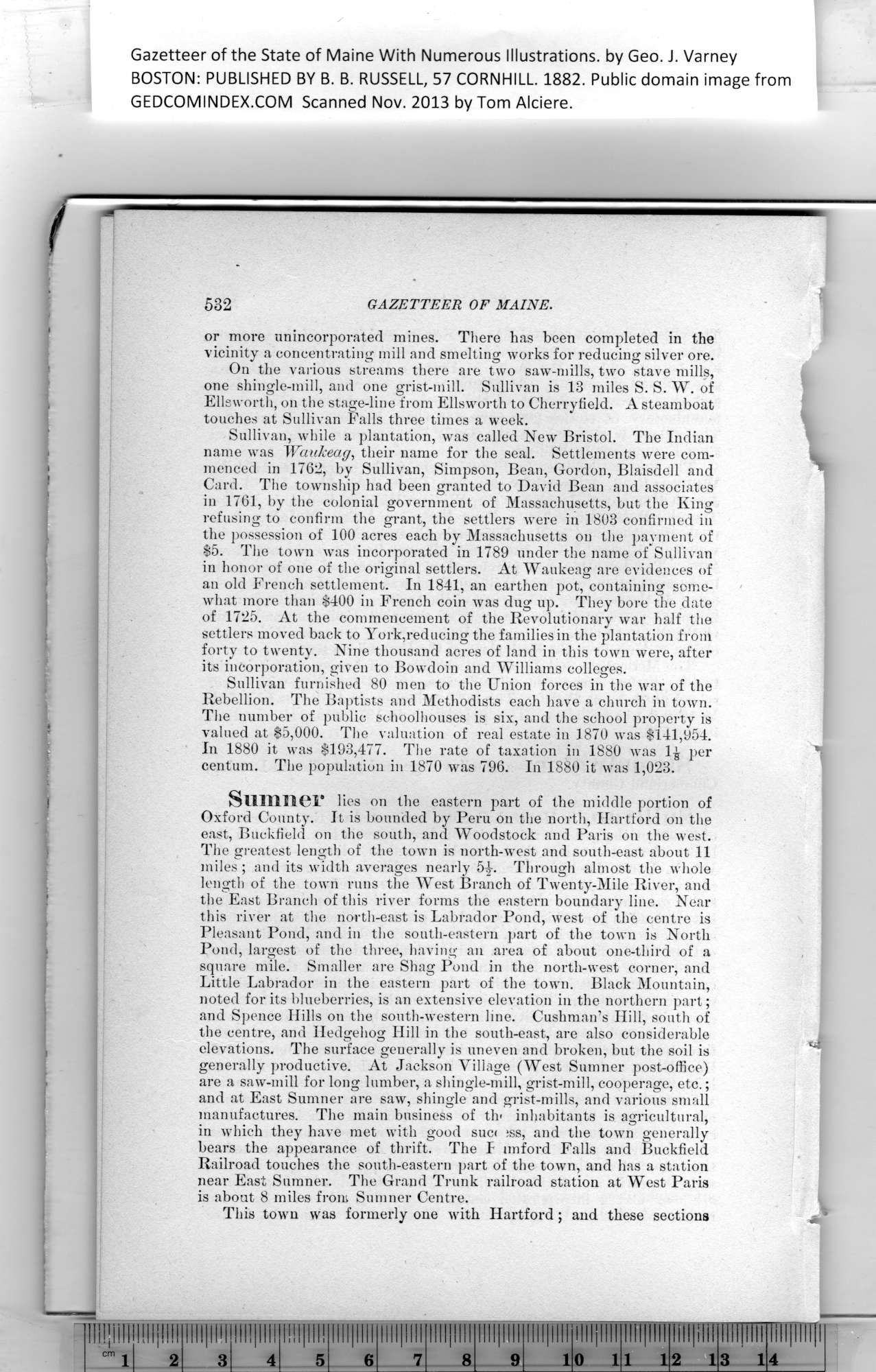|
Gazetteer of the State of Maine With Numerous Illustrations, by Geo. J. Varney
BOSTON: PUBLISHED BY B. B. RUSSELL, 57 CORNHILL. 1882. Public domain image from
532 GAZETTEER OF MAINE.
or more unincorporated mines. There has been completed in the
vicinity a concentrating mill and smelting works for reducing silver ore.
On the various streams there are two saw-mills, two stave mills,
one shingle-mill, and one grist-mill. Sullivan is 13 miles S. S. W. of
Ellsworth, on the stage-line from Ellsworth to Cherryfield. A steamboat
touches at Sullivan Falls three times a week.
Sullivan, while a plantation, was called New Bristol. The Indian
name was Waukeag, their name for the seal. Settlements were com-
menced in 1762, by Sullivan, Simpson, Bean, Gordon, Blaisdell and
Card. The township had been granted to David Bean and associates
in 1761, by the colonial government of Massachusetts, but the King
refusing to confirm the grant, the settlers were in 1803 confirmed in
the possession of 100 acres each by Massachusetts on the payment of
$5. The town was incorporated in 1789 under the name of Sullivan
in honor of one of the original settlers. At Waukeag are evidences of
an old French settlement. In 1841, an earthen pot, containing some-
what more than $400 in French coin was dug up. They bore the date
of 1725. At the commencement of the Revolutionary war half the
settlers moved back to York,reducing the families in the plantation from
forty to twenty. Nine thousand acres of land in this town were, after
its incorporation, given to Bowdoin and Williams colleges.
Sullivan furnished 80 men to the Union forces in the war of the
Rebellion. The Baptists and Methodists each have a church in town.
The number of public schoolhouses is six, and the school property is
valued at $5,000. The valuation of real estate in J 870 was $141,954.
In 1880 it was $193,477. The rate of taxation in 1880 was 1^ per
centum. The population in 1870 was 796. In 1880 it was 1,023.
Sumner lies on the eastern part of the middle portion of
Oxford County. It is hounded by Peru on the north, Hartford on the
east, Buckfield on the south, and Woodstock and Paris on the west.
The greatest length of the town is north-west and south-east about 11
miles ; and its width averages nearly 54. Through almost the whole
length of the town runs the West Branch of Twenty-Mile River, and
the East Branch of this river forms the eastern boundary line. Near
this river at the north-east is Labrador Pond, west of the centre is
Pleasant Pond, and in the south-eastern part of the town is North
Pond, largest of the three, having an area of ahout one-third of a
square mile. Smaller are Shag Pond in the north-west corner, and
Little Labrador in the eastern part of the town. Black Mountain,
noted forits blueberries, is an extensive elevation in the northern part;
and Spence Hills on the south-western line. Cushman’s Hill, south of
the centre, and Hedgehog Hill in the south-east, are also considerable
elevations. The surface generally is uneven and broken, but the soil is
generally productive. At Jackson Village (West Sumner post-office)
are a saw-mill for long lumber, a shingle-mill, grist-mill, cooperage, etc.;
and at East Sumner are saw, shingle and grist-mills, and various small
manufactures. The main business of th< inhabitants is agricultural,
in which they have met with good suet ;ss, and the town generally
hears the appearance of thrift. The P unford Falls and Buckfield
Railroad touches the south-eastern part of the town, and has a station
near East Sumner. The Grand Trunk railroad station at West Paris
is about 8 miles from Sumner Centre.
This town was formerly one with Hartford; and these sections
PREVIOUS PAGE ... NEXT PAGE
This page was written in HTML using a program written in Python 3.2
|
